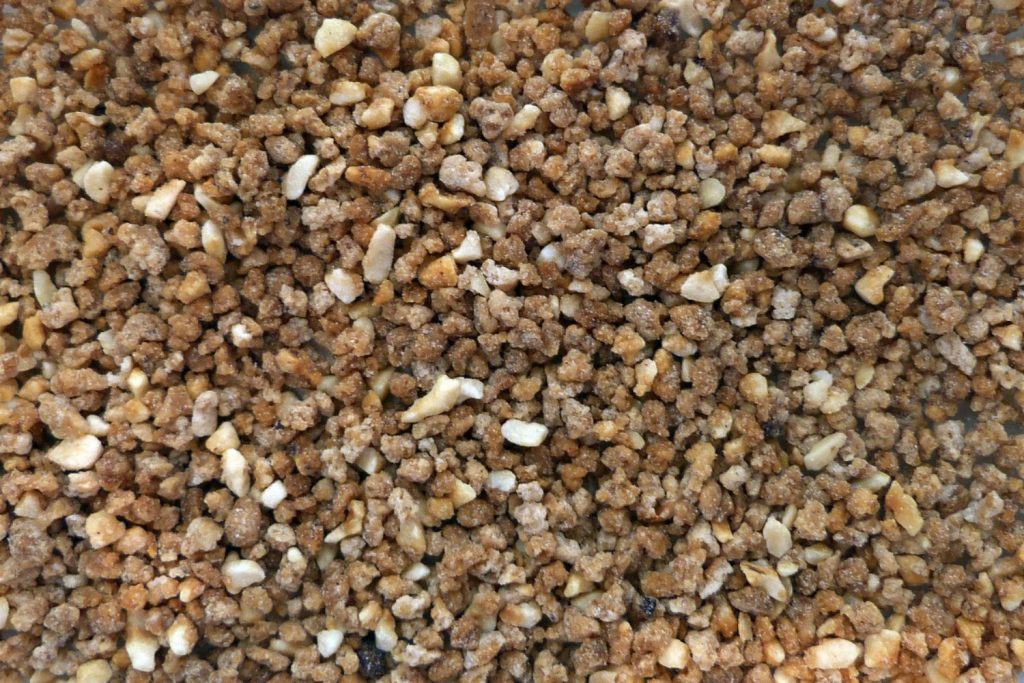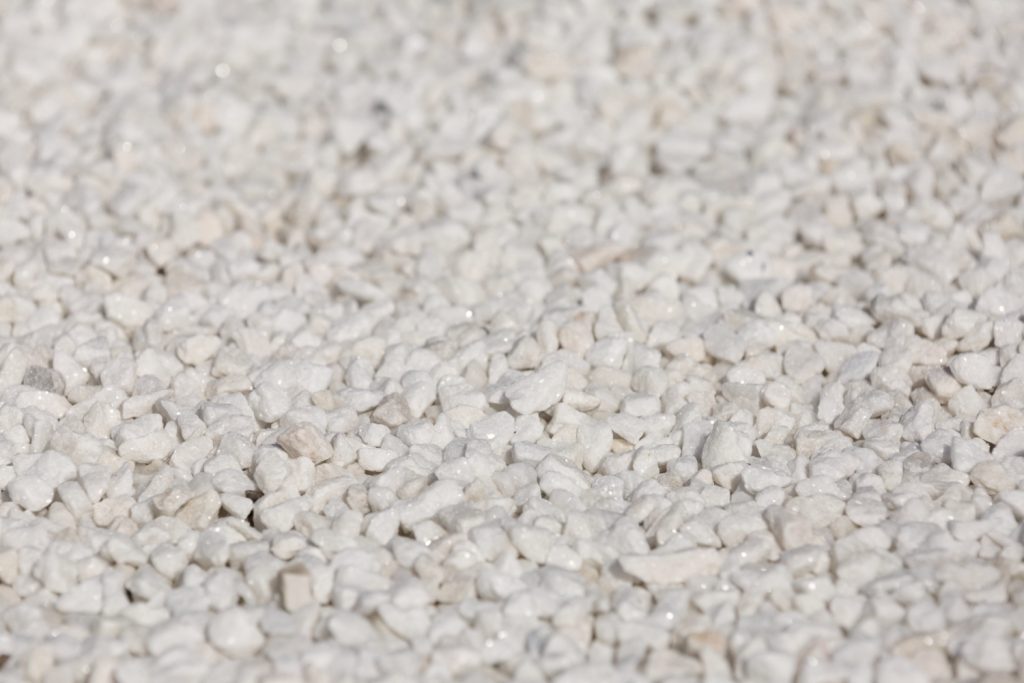

We’re here to help! Wild Yards is a completely free website that is 100% dedicated to helping you create a wildlife-friendly, sustainable yard. Read more
WildYards is reader-supported. When you buy a product through a link on our site, we may earn a comission. Every product is independently selected by our (obsessive) editors and our reviews are unbiased and objective. Read more about our mission or our privacy policy.
Horticultural sand is an ingredient used in many potting soil mixes. This coarse, gritty sand helps keep soil light, loose, and fluffy, allowing for maximum aeration and good drainage.
This type of sand is especially useful when creating your own seedling soil mixes because it enables the soil to retain some moisture, but allows excess water to drain quickly.
Unfortunately, horticultural sand can be difficult to track down, and it’s often sold in small bags that can get pricey quickly if you need a large amount.
The good news is, you can substitute builder’s sand or any other sharp gritty sand for horticultural sand. These types of sand are usually easier to find, and much less expensive.
But before we dive too deeply into horticultural sand alternatives, let’s find out just what horticultural sand is and when to use it in the garden.
Horticultural sand is used to loosen up boggy, compacted soils. This soil amendment can be mixed with loamy, overly fertile soils, and/or soils that tend to stay too moist to create a better substrate for the plants in your garden.
What is horticultural sand?
Made from crushed granite, sandstone, quartz, and other types of rock, horticultural sand is also known as sharp sand or coarse sand.
This type of sand is quite gritty and is most often used to amend overly-compacted soils. Adding horticultural sand to a substrate makes it more porous, so water and air can penetrate more easily.
Horticultural sand does not clump together, like some other types of sand. Instead, it remains loose, almost like beach sand, even when saturated with water.
One good thing to note about horticultural sand is that it does not contain crushed limestone. Although lime in itself is not necessarily a bad thing, it can alter soil pH, making it more acidic over time.

What are the benefits of horticultural sand?
Horticultural sand can be incredibly useful, and it definitely deserves a spot on a shelf in your potting shed. But what exactly are the benefits of horticultural sand? Let’s find out!
Improves drainage and aeration
We’ve already touched on this, but one of the main benefits of horticultural sand is that it promotes soil drainage and makes it easier for oxygen to reach your plant’s roots.
Horticultural sand has a somewhat coarse texture.
When mixed with compost and other organic materials, horticultural sand encourages adequate moisture retention while also enabling excess water to run off quickly.

Reduces the risk of root rot
Because it promotes good drainage and increases air circulation, horticultural sand helps prevent root rot in plants that are susceptible to it.
The pathogens that cause root rot thrive in water. Moist soils are a breeding ground for these spores.
Mixing a healthy dose of horticultural sand into loamy, overly fertile soil discourages the development of unhealthy anaerobic bacteria.
It also ensures the healthy bacteria in the soil have plenty of oxygen, so they can continue to outnumber the unhealthy bacteria and keep your plants healthy.

Adds structure to the soil
If your soil is too compacted, or if it’s overloaded with organic materials that prevent it from draining well, horticultural sand can be used to give it some structure.
Horticultural sand is lightweight, so it’s perfect for breaking up heavy soils.
It also prevents compaction, even in the presence of high foot traffic.
Improving soil structure enables your plants to grow stronger roots and get established much more quickly.
This can even support nutrient uptake by giving plants the right amounts of water and air.

Alleviates transplant shock
Transplanting can be stressful for both the gardener and the plant.
Moving plants to compacted soils can make it difficult for the plants to recover. That’s because compacted soils aren’t easy to root into.
If your plants can’t produce strong, healthy roots, then they may never recover from the transplanting process.
But amending your soil with horticultural sand keeps things nice and loose, so your plants can get started on the right foot.
If your sand is clay-rich, adding some compost along with the horticultural sand will add even more structure.

Good for starting seeds and propagating cuttings
Starting new plants can be tricky.
Seeds and cuttings need some moisture retention. But too much water can drown them.
Using horticultural sand as a growing medium for seeds and cuttings promotes healthy growth by keeping plants hydrated, but not overhydrated.
Horticultural sand’s fast-draining properties make it uniquely suited to starting vegetable seedlings and cuttings from your favorite ornamental plants.
When should you use horticultural sand in your garden?
You should use horticultural sand to improve drainage for your plants, whether they’re growing in raised beds, containers, or straight in the ground.
Soils that tend to stay wet for days after rain, clay-dominant soils that are extremely compacted, and overly fertile soils typically benefit from horticultural sand.
You should also keep your plant’s soil requirements in mind.
Certain plants, like cacti, succulents, and Mediterranean-native herbs like sage, lavender, and rosemary, typically prefer sandy soils.
Horticultural sand can be added to less-than-ideal native soils to create an ideal growing medium for plants that prefer sandy soils.
Overall, horticultural sand is an excellent ingredient in many soil mixes because it improves soil structure and makes it easier for plants to grow strong, healthy roots.

Can you use horticultural sand on your lawn?
Grass needs good aeration and proper drainage, the same as any other plant.
If your native soil is rich in organic materials to the point that it holds onto too much water, then adding horticultural sand as a top dressing can help improve the substrate over time.
There are two ways to apply horticultural sand to a lawn.
The first is to mix the horticultural sand with the soil before seeding the lawn or laying the turf.
This is the preferred method of application simply because it’s the easiest. But, unfortunately, if your grass has already been planted, then it isn’t an option.
So instead, you’ll need to apply the sand as you would a fertilizer. Scatter a thin layer of horticultural sand onto your turf by hand or by using a broadcast spreader.
Walking across your lawn while wearing aerator shoes afterward helps work the sand into the soil a bit.
How much horticultural sand should you add to potting mix?
Mixing your own soil is something of an art. Fortunately, you don’t have to be too precise in your measurements.
The general rule of thumb is to mix one part of horticultural sand with three parts of potting mix.
You can also mix horticultural sand in with compost at a rate of one part sand and two parts compost to feed plants that need better drainage.
Horticultural sand can be mixed with other materials like perlite and sphagnum peat moss to improve drainage while also supporting adequate water retention.
Ideally, you want to create a loamy soil mixture that has a variety of soil particle sizes, from coarse grit, like horticultural sand, to fine silt.
This combination of soils creates a mix that has structure. Adding organic materials, like compost and manure, enriches the soil making it more nutritious for your plants.

4 Alternatives to horticultural sand
It’s not always easy to track down horticultural sand. And, even if you can find it, it can be pretty expensive, especially if you need to amend a large area, like a vegetable garden bed.
The good news is that there are several alternatives to horticultural sand that work just as well.
Builder’s sand
Builder’s sand is very similar to horticultural sand in texture, but it is somewhat coarser.
This type of sand is commonly used in construction, hence the name. Builder’s sand can be mixed with cement to create mortar, or used as a base for bricklaying.
Because builder’s sand is coarser than horticultural sand, you may not need to use as much of it to make your soil more loamy.
You can typically purchase builder’s sand by the yard.
You can also find Quikcrete All-Purpose Sand at most hardware stores. Look for Quikcrete Commercial Grade Medium Sand if you’re looking for sand with a somewhat finer texture.

Grit
If you can’t track down builder’s sand, another good alternative to horticultural sand is grit.
But, be advised, grit is somewhat high in salt. So it needs to be rinsed thoroughly before being added to your soil.
Grit is made from crushed rocks and/or minerals, and tends to be coarser than horticultural sand.
Like horticultural sand, grit is often used in seedling soil mixes to keep the soil loose and loamy. Grit improves drainage and promotes aeration.
You can add grit to the bottom of a pot to keep drainage holes from clogging up. You can also use it as a top dressing to provide plants with some added stability.
Vermiculite
Vermiculite is a lightweight, sterile, and absorbable mineral that can be used in place of, or in combination with horticultural sand.
Derived from mica, which is a silicate mineral, vermiculite is similar in texture to rock salt.
These large particles improve drainage preventing moisture build-up. They also prevent compaction to ensure your plants get all of the oxygen their roots need to stay healthy.
Vermiculite has moderate cation exchange capacity, which means it acts as a storehouse of nutrients for plants, which they can pull from as they need it.
Vermiculite is a source of trace minerals like iron and magnesium which plants need to stay healthy.

Perlite
Made from volcanic glass, perlite is lightweight and porous, similar to pumice.
Like vermiculite, perlite is about the size of rock salt. It’s often used to prevent soil from becoming too compacted.
You can mix perlite with builder’s sand, grit, vermiculite, or any other soil amendment to improve drainage and aeration.
Of course, you can also use perlite on its own if you prefer.
Perlite acts as a soil insulator, keeping the soil nice and warm.
It’s an ideal substitute for horticultural sand in seed starting. Perlite helps keep the soil at a suitable temperature to promote seed germination.

Tips for using horticultural sand properly
Using horticultural sand isn’t exactly a science. However, there are a few things you’ll need to keep in mind to ensure you use horticultural sand properly.
For starters, choose the right grade. Use coarser sands for soils that require more drainage. If your soil already drains fairly well, then medium to fine-grade sands will work better.
Be sure to mix the sand in with organic materials, like compost. This tempers the effects of both materials, creating a more suitable substrate for your plants.
Once you’ve amended your soil with horticultural sand, you’ll need to adjust your watering schedule. Always feel an inch below the soil before watering. If the soil still feels wet, allow it to dry out a bit before watering.
Horticultural sand is easy to use, and when combined with other amendments, plays an invaluable role in creating a healthy soil environment for the plants in your garden.
